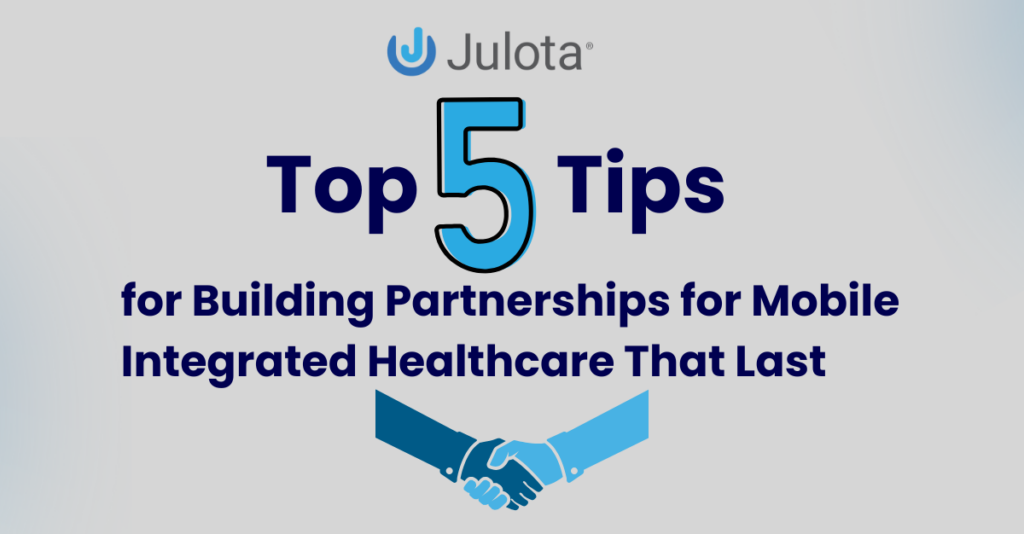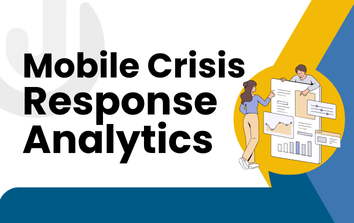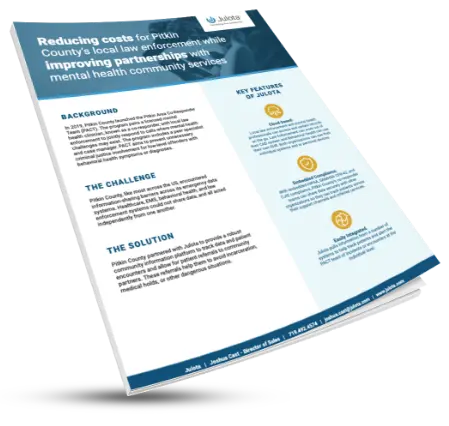Building partnerships for mobile integrated healthcare is like building the foundation of a home: absolutely critical to long-term strength and survival. Building partnerships isn’t always easy, but it is always positive for everyone involved, ultimately allowing a community to create synergy, achieving more than they ever could alone.
A few tips for building partnerships within your Mobile Integrated Healthcare (MIH) program include finding common ground, performing a needs assessment, sharing data safely and reliably, spreading out costs, and encouraging innovations. There are many ways to foster good relations in community paramedicine, and we’ll talk about at least five of them (and a few bonus tips) below. Let’s go!

How to Build Strong Community Partnerships for Mobile Integrated Healthcare-Community Paramedicine
Not only do strong partnerships in MIH give you increased security as a program, but they improve your efficiency and impact. Rest assured: time thinking about how to form new partnerships in Mobile Integrated Healthcare is time well spent.
Because when you don’t form any partnerships, the outcome is pretty bleak. In most cases, programs that make little to no effort to form strong partnerships make little to no impact in the community, rarely see returns on their effort, and end up wasting time and money.
Mobile Integrated Healthcare uses the word “integrated” because it’s a system where people work together. This means that the hospital works with the EMS service and the fire department. But it even goes beyond that, with EMS often working with mental health professionals, social workers, and rehab clinicians.
We can’t overemphasize (truly, we can’t), the importance of good partnerships in Mobile Integrated Health. For that reason, let’s discuss some of the ways to make connections, keep them strong, and get them growing.
Here are five tips for building mobile integrated healthcare partnerships that last:
- Perform a Needs Assessment
- Find Areas of Common Ground
- Collect and Share data Regularly
- Spread Out Costs
- Encourage Innovation in Community Health
We’ll talk more details of each of these below.
Building Lasting Partnerships in Mobile Integrated Healthcare (MIH): Performing a Needs Assessment
Why does a needs assessment help you create lasting partnerships? Because a needs assessment demonstrates that you have a truly widespread issue that deserves the community’s attention.
For example, if you’re trying to partner with a rehab facility, showing them a needs assessment that demonstrates there are people who will regularly require their services will be a lot more convincing (and long-lasting), than just saying, “Hey, wouldn’t that be a cool idea?”
When it comes to business and money, people want to see that their time and capital does not go to waste. You wouldn’t try to sell steaks to vegetarians, and you shouldn’t try to start a new community program without proof that they are necessary and will provide a benefit to everyone involved.
Creating Lasting Partnerships in Mobile Integrated Healthcare by Finding Areas of Synergy
The second way you can build a lasting partnership is by finding win-win situations. This is also known as synergy, where two things are improved because they are working together. In nature, they call this a symbiotic relationship, where two organisms rely on each other and are all the better for it.
So what does this look like? Well, perhaps it’s something like funding an alternative destination protocol. You’re trying to build a team that will help reduce the number of people in the ER. A natural partner in this effort would be the ER itself, and it’s a win-win. Not only does your EMS system have fewer emergency transports, but the ER has less overcrowding.
There are little victories like this all over Mobile Integrated Healthcare, and it’s important to find them and pitch them to potential partners. The reason win-win situations are so great is that nobody feels like they are the one losing or getting the bad end of the deal.
Form Lasting Partnerships in Mobile Integrated Healthcare Collecting by Sharing Data
Lasting partnerships in any part of life are about trust, and trust is built when people are honest with each other. As we all know, telling a lie is not the only way people can be dishonest. Withholding certain information is another way dishonesty creeps in. This must be avoided.
For example, say you started an MIH program to address chronic diseases; however, it’s not doing so well. You haven’t been able to get people enrolled, and those that are enrolled are not following through with appointments. It might be tempting to withhold this information, but if you do, you will break the trust of your partner.
A better method would be to keep everything open. If a specific program isn’t going as planned, call a meeting and work it out. Sharing is important – and information isn’t the only thing worth sharing.
Building Lasting Partnerships in Mobile Integrated Healthcare: Spreading Out Costs
Finding the money to fund a mobile integrated health program can be daunting; however, it’s possible if you have the right approach. When it comes to maintaining partnerships, a lack of transparency or equity around cost sharing can be a concern. There are a couple ways you can address this.
First, make sure you have a clear breakdown of costs. How much does it cost to staff everything, supplies, vehicles, etc. This will ensure that nothing is missed. Then, try to break things up in a way that makes sense. You have to find some angle where the financial investment of a partner makes sense.
While it would be great if everyone did things out of the goodness of their heart, healthcare needs to be funded, and partners will want to know that they are getting some return on investment.
So keep things open, share whenever possible, and look for creative ways to save.
Building Lasting Partnerships in Mobile Integrated Healthcare: Encouraging Innovation in Community Health
Finally, encouraging innovation is a great way to maintain good partnerships in Mobile Integrated Healthcare. Even if something is working on paper, people get tired of the same-old-same old. Always try to encourage partners to think outside the box and to present new ideas.
Mobile Integrated Healthcare is definitely not the place for a “this is the way we’ve always done things” mindset. Once things become stale, the end of the partnership and the MIH program is near.
Bonus: Staying Connected on an Efficient Platform to Build Long-Term Connections
You know that friend who is always changing their cell phone number? Kind of hard to keep in touch with them. The same thing is true of mobile integrated healthcare. If you don’t have a central network upon which your communication is based, people will become really lost really fast.
Make no mistake: a breakdown of communication is one of the fastest ways to destroy partnerships and prevent long-term growth. This is why it’s essential that you have a platform everyone is familiar and comfortable with, as well as something that will keep information private and allow you to collect and share data when needed.
If you’re looking for just such a service, be sure to check out Julota’s software platform for mobile integrated healthcare. These tools are safe, efficient, and easy for new partners to learn. If you’re curious, take some time to read more about Julota’s cloud based service.
Bonus: Getting Input from the Community Members
Another way to keep your MIH partners happy: have proof that what you’re doing is positively impacting the community. Have a representative attend town hall meetings, take part in community events, make yourselves known to everyone – not just those that you are directly helping.
This approach can give you several advantages: first, it’s a quick way to get a rough survey of what people think of your program. Second, it’s a great way to create new partnerships. If you can go to a potential partner (say, a clinic you want to team up with) and tell them, “There was a lot interest and enthusiasm in this project when it was presented to the community,” they will take your proposition much more seriously.
Now let’s go over a few key points.
Key Takeaway: How to Build Partnerships for Community Paramedic Programs and MIH
So how do you keep your friends around when trying to build an effective Mobile Integrated Health Program? Well, pretty much the same way you do with your good friends in everyday life. You keep in touch with them (don’t change your number too many times), you share information with them, take turns paying for lunch, and listen to each other’s struggles.
You’ll find that when building partnerships in Mobile Integrated Health these basic principles apply. A few things you can do to get an edge include collecting data and presenting it in a compelling way (For example: “We know that we lose X amount of money to super-utilizers. Here’s a solution”). When you can talk real numbers, people listen.
Finally, you’ve got to ensure that you have more than just a stray email address – you must connect with your partners on a platform built for the job. If you’re interested in such a platform, be sure to contact Julota. A team member at Julota would be more than glad to hear your needs, answer questions, and provide a simple demonstration.
Author
-

Noah Weinberg is a Marketing Associate at Julota, where he focuses on elevating the alternative response space, specifically Mobile Integrated Healthcare (MIH), Community Paramedicine, and co-responder models. He writes about the intersection of law enforcement, healthcare, and community well-being, drawing on real-world experiences with community paramedicine programs in Ontario, Canada.




